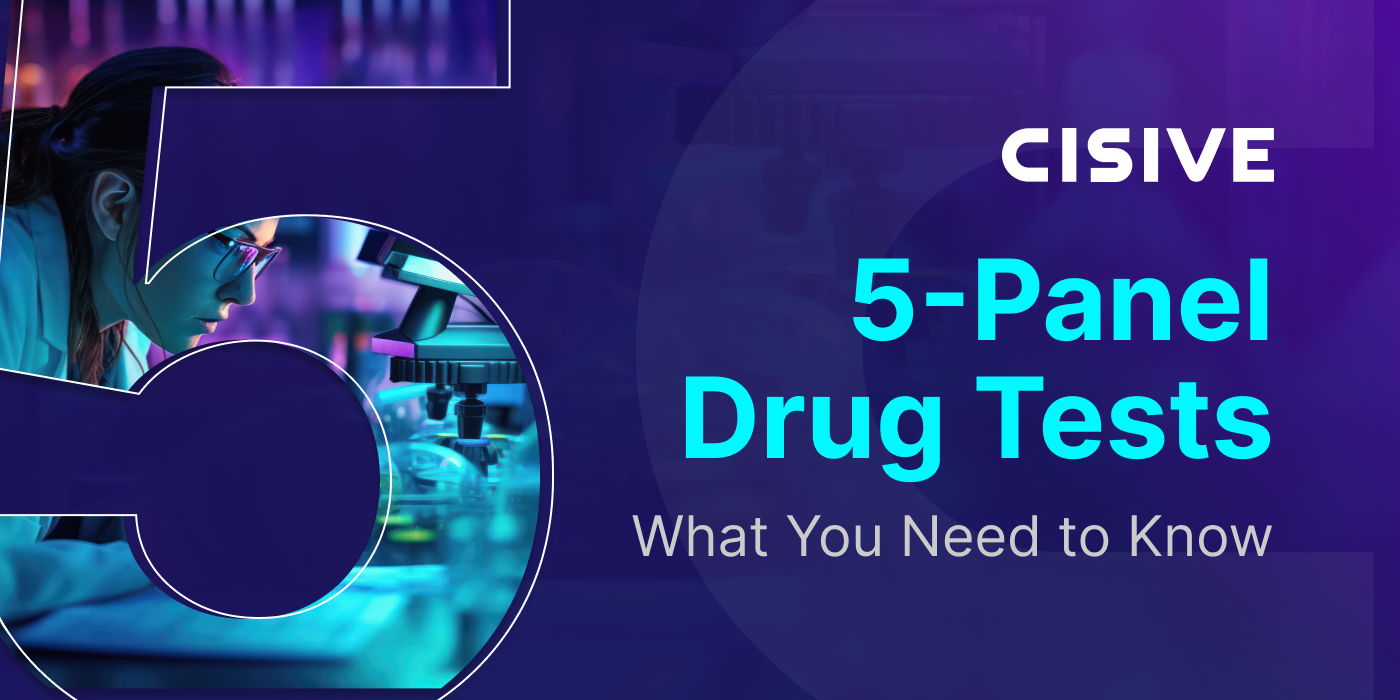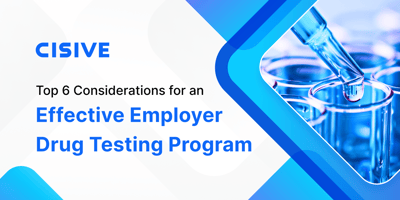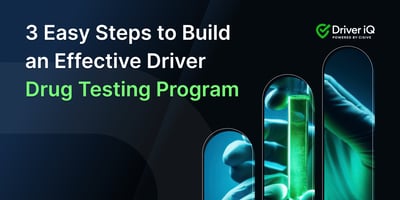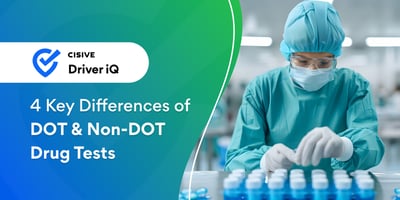

Employer drug testing is pivotal to ensuring workplace safety, mitigating risks and costs,...

Pre-employment drug screening is an important step in making sure you have the right candidates for the job. Once hired, employee drug testing helps maintain workplace safety and ensures productivity.
The 5-panel drug test is a solution many federal and private employers use for convenient, efficient drug testing.
Key TakeawaysHere are the key things you need to know about 5-panel drug tests:
|
A 5-panel drug test is a standardized drug screening tool employers use to detect the presence of five types of controlled substances.
The test can detect commonly abused prescription drugs and illegal substances. The sample tested is usually urine; however, hair follicle, sweat, and blood tests are also options.
Government agencies, such as the Department of Transportation (DOT), require a 5-panel drug test for preemployment and other situations. A non-DOT 5-panel drug test is popular with other types of employers as well. This test targets the five types of most commonly abused and dangerous drugs that threaten workplace safety and increase employers' risk. Other more heavily regulated industries, such as law enforcement or health care, often require more in-depth screening. However, for most employers, the 5-panel drug test is the best choice for regular workplace drug testing because of its accuracy, affordability, and convenience.
The standardized DOT 5-panel drug test screens for the following substances:

DOT testing requires using DOT-certified labs and specimen collectors.
The 5-panel drug test works by screening for chemical byproducts, called metabolites, that remain in someone's system after their body breaks down certain substances. Each drug leaves detectable metabolites for a specific period of time.
The detection timeframe depends on both the drug and the type of test. For example, a hair follicle test can detect previous THC use for up to 90 days, while a saliva test will only detect THC metabolites for up to 24 hours.
How often a person uses a drug and how much they use can also affect the metabolic detection timeframe. Someone who smokes marijuana occasionally may have no detectable THC after a few days, while a daily user can have a detection window of up to 30 days.
Here are the average estimated detection times for each substance in a 5-panel drug test based on a urine sample.

The time it takes to receive results for a 5-panel drug test depends on a number of factors. The first one is the process of taking the test.
Here at Cisive, we handle sample collection and lab testing. We have testing sites across the country that we match with your candidate's location to make sample collection as rapid and convenient as possible.
Once the sample is collected, it needs to be sent to a lab for testing.
After the lab receives the sample, the wait time for results depends on the efficiency of the lab itself. Due to all these factors, negative results from lab-based testing can come back as quickly as a single day, and non-negative results may take up to 3 days.
The results of the 5-panel drug test affect the reporting timeframe because each result is handled differently. Three results are possible, which are:
A negative test result means that no metabolites from any of the drugs screened were above cutoff levels. Because there's no further action taken after a negative test, the results are reported immediately.
A positive employee drug test result indicates that metabolites from one or more drugs were detected above the cutoff levels. A positive test will usually require additional steps.
For example, if the drug is a prescription drug, the provider from the testing site would want to verify with the candidate that they have a valid prescription for the substance and that the levels are consistent with the prescribed dose. Some over-the-counter medications, such as Sudafed or Robitussin, can sometimes cause false positive results.
Further testing is usually done to verify a positive result, which is why positive tests take longer to report.
An inconclusive result means that no result was found. This can be for a number of reasons, such as a faulty test or a testing error. However, sometimes, it's because the candidate attempted to dilute their urine by drinking an excessive amount of water or used another method to obscure the results of the drug test intentionally.
For the most part, private employers are neither prohibited nor required by federal laws to create an employee drug testing policy. One exception would be a private company that contracts with the federal government and falls under the scope of the Drug-Free Workplace Act of 1988.
However, many federal and state regulations do apply to employee drug testing, primarily by protecting individual rights. Because employees and candidates have filed lawsuits against employers for discrimination, defamation, and invasion of privacy, it's important for employers to be aware of all state and federal regulations and how they should be followed.
Some of the most important include:
Title VII of the Civil Rights Act requires employers to administer drug tests in a manner that is fair, equal, and not influenced by any candidate or employee's sex, religion, nationality, or race. Your drug testing policy should be fairly enforced, culturally competent, and sensitive to the needs of all employees.
The ADA doesn't protect employees who currently use illegal drugs; however, it does offer protection to those who are recovering substance abusers in treatment or have a history of past substance abuse. Employers can't refuse to hire candidates because of past drug use or for current enrollment in a drug or alcohol rehabilitation program.
Under this federal law, employers also can't single out those with a history of substance abuse for additional drug testing.
Because the FCRA governs consumer reports, third-party candidate and employee drug test results can fall under FCRA guidelines. Employers are required to provide written notice of their drug testing policy and receive written consent before conducting the drug test.
The FCRA also covers the responsibilities that employers have in delivering a decision based on a negative drug test result, called an "adverse action notice," and the rights of the candidate or employee who receives the notice, including the ability to appeal.
Many states and major cities have regulations that govern drug testing policies that are typically designed to protect the rights of candidates and employees. For example, some states only require written notice of a pre-employment drug test, while others also require a list of the specific substances that will be tested.
Some states have specific laws that directly impact preemployment drug testing due to the widespread legalization and decriminalization of marijuana. For example, some states bar employers from refusing to hire based on a positive test for THC, while others prohibit testing for THC altogether.
To prevent violations and potential lawsuits, your company should seek legal counsel before implementing a drug testing policy to ensure compliance with all federal, state, and local regulations.
Implementing a drug testing program utilizing a 5-panel drug test can help your company minimize risk, improve productivity, and increase workplace safety. Partnering with a reputable employment screening service, such as Cisive, can help ensure your company stays compliant with federal, state, and local regulations in the process.
Cisive handles every aspect of screening with convenient, flexible, and comprehensive drug testing options. With on-site, mobile, and lab-based sample collection, accurate drug testing can become a seamless part of your organization's hiring process and operation.
To find out more about how Cisive’s 5-panel drug test screening service could work for your company, speak to an expert today.
Author: Jessica McDonald
Bio: Product Strategy and Development, Drug Testing and Occupational Health Subject Matter Expert at Cisive
Let's Connect on LinkedIn
Employer drug testing is pivotal to ensuring workplace safety, mitigating risks and costs,...

Motor carriers need to hire drivers who are safe and reliable, both for the public’s safety and...

No matter how many employees you have, you're responsible for keeping them safe. Employers also...